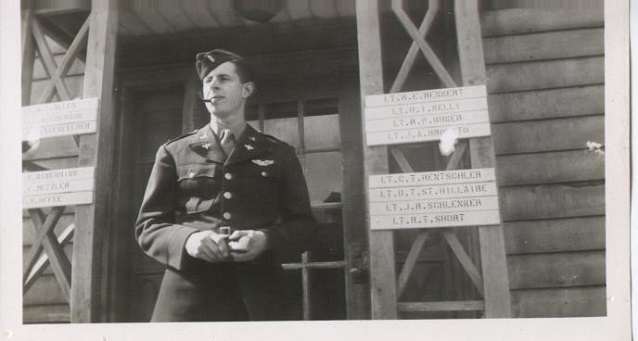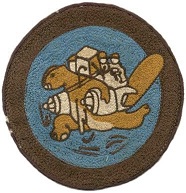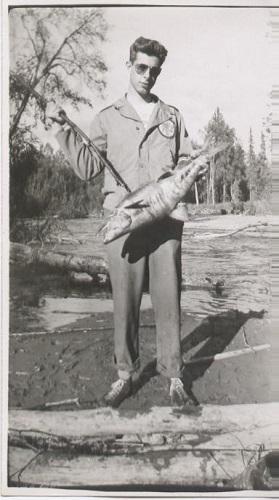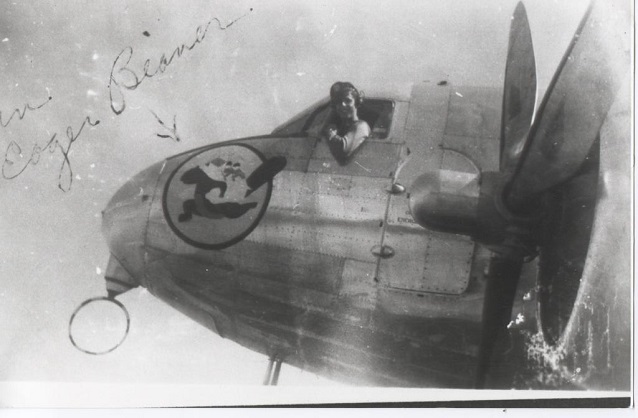Christmas time 1944, 17 new pilots arrived in Alaska. Lt. Richard Short, describing himself as an apple-cheeked boy of 20 from Omaha, Nebraska and newly graduated from flight school, recalls the time.

Courtesy of Richard T. Short II (son), from the collection of 1st Lt. Richard T. Short
We arrived in Anchorage about Christmas time, 1944. Snow and cold greeted us and we were sent out to the outskirts of Fort Richardson under control of the Army Command, who were not too happy with these so called, “fly boys”, who received 50% more pay for flying at least four hours per month.

Courtesy of Richard T. Short II (son), from the collection of 1st Lt. Richard T. Short
In the middle of the forest with deep snow and bitter cold, we were placed in small Quonset huts with a kerosene heater in the center of the hut, which barely worked and was totally inadequate. For several days we were given nothing to do, except to fall out at about 6:00 am and answer roll calls, after climbing down several flights of steep stairs covered with deep snow and then sent back to our hut. We saw no reason for the charade. We did not fall out for roll call. After being threatened with dire consequences, we were told we would be court marshaled or given the 104 Article of War. The Army was going to make examples of us, until the 54th C.O. Colonel Grosssmith called the Army telling them to send the pilots over to his squadron. So we became members of the 54th Troop Carrier Squadron, a nice Christmas present.
We were assigned four men to non-commissioned officers’ apartments, with our indoctrination beginning with local flights and becoming familiar with the C-47 and local area. The next step was to accompany as a third pilot on trips out to the chain of islands to learn the actual routine of flying with radio beams and directional radio compasses. Also when to fly and when not to fly, to follow the radio beams religiously, and practice locally blind flying along with link training.
Instrument flying, when we would fly from base to base and the weather was a solid overcast, we flew at about 7,000 to 10,000 feet using the radio beams as highways. When we would pass over the beam transmitting station, which was close to the runway, the radio altimeter would suddenly start spinning and the noise from the beams would go silent, letting you know you were directly over the station. From there you would begin your descent using one of the radio beams as a reference point. So you timed your distance away from the station then made a 180 degree turn all the time letting down hoping to break out of the overcast so you could see and land visibly. However, in overcast weather you usually did not break out until you got close to the ocean. Then hugging the ocean you found the runway. If you were not lucky, then you used the zero, zero approach.
During the summer months when you would check your destination, the report would be clear and CFR[Contact Flight Rules] conditions, but when or before you got to your destination in a short period of time, the land areas would suddenly develop a ground layer of fog, maybe 50 to 100 feet off the ground so that everything above the fog was clear. It was an odd sight to see everything above 100 feet to be free and clear above the fog.

Courtesy of Richard T. Short II (son), from the collection of 1st Lt. Richard T. Short
You would leave Elmendorf Field early in the morning 5:00 or 6:00 am with a load of freight and replacement soldiers for the Aleutian bases. Our crew consisted of a pilot, a co-pilot, radioman and a crew chief. The pilot usually was a First Lieutenant or Captain, with the co-pilot usually a Second Lieutenant. We would start down the Kenai Peninsula, then carefully through the pass with mountains on both sides of you, higher than your cruising altitude. You were taught to pay attention here if you were not CFR. We then began our milk run, stopping at Port Heiden and Naknek if we had something for them. Their runways were just carved out of rock and tundra, being a little hazardous to land on at times. Later on R&R men would be flown into Naknek for fabulous fishing trips, one cast, and one fish.
After leaving Naknek it was on to Cold Bay and then Umnak. From Umnak if it was getting late in the day, we would stop at Adak and R.O.N. (remain over night). Or if we did not have to make many stops, we would go on to Shemya or Attu. At Attu you would see Navy bombers, as they were taking off to bomb the northern Japanese islands. After Attu you would turn around and head back to Elmendorf, stopping at those bases on the way back that you had freight for. We had pilots that would fly to Adak and return home within the same 24 hour period, especially during the summer when you had 24-hour daylight.
After a flight your name was placed at the bottom of the list of names in operations. You didn’t fly again until your name came to the top. There were periods when you didn’t have a flight for three or four days and as long as a week. You were required to report each afternoon at Operations for a meeting where we usually had a ball playing ping pong and socializing. We were required to read the latest maintenance manuals and occasionally served as Officer of the Day. Also we were regularly; scheduled for link training or practiced instrument flying locally which consisted of flying the plane totally on instruments even though the co-pilot could see and you were actually CFR. Otherwise your time was your own, with many trips to Anchorage.
Getting back to the island bases, there were some that were difficult to land on if the weather was not the best. One was Adak where you had to come in off the ocean heading west. If you missed your approach it was tough sledding because there were hills on the west, north and south sides of the runway. The runway started right at the waters’ edge. The clouds were usually low 50 to 100 feet so you were right on the deck. Attu was the same, if you couldn’t see the runway soon enough you had better turn and get out, trying something else because Attu was a short runway.
Shemya was a whole different story with the whole island being just one long runway with absolutely no obstructions to run into. In case you missed your first pass, thank God for the Bartow lights on each side of the runway which helped orientate as to where the runway was. Many times visibility was zero and so bad you could see only one row of Bartow lights. You didn’t know which side of the row the runway was on. Then just as you were ready to go around making another pass, you would spot the other row and swiftly line up and set the plane down safely with the tower asking you for your location, as they did not know you had landed because they could not see 100 feet.
Usually if they had 100 foot ceiling over the runway we would drop down to the ocean staying below the overcast making for us an easy landing. Our planes would fly when no one else would fly the chain due to bad weather. There were airline pilots flying for the ATC (Air Transport Command) who would not venture out in the kind of weather we called “routine”.
I remember one trip at Cold Bay where the winds blew at about 100 mph for several days. The forecast was for several more days. The wind direction finally swung right down the runway. One of the 54th pilots decided to take off in it figuring it was straight down the runway. He did, with the plane instead of roaring away, it seemed to rise vertically and of course once he was in the air, the wind strength meant nothing, so I got my crew, doing the same thing, no problem.
Icing of the wings was a periodic problem, but when you dropped down in altitude it started to melt. The spraying of isopropyl helped to melt the ice on the windshield, which at times, was two to three inches thick. Our pilots had so perfected their skills that zero ceiling and zero visibility did not stop them from landing. In other words, we could get in without having to go around making another attempt.

Courtesy of Richard T. Short II (son), from the collection of 1st Lt. Richard T. Short
We also had on our C-47’s a radio altimeter which was very useful when attempting a landing, where you could not see the runway. If my memory serves me correctly, we used this unit from about 100 feet down to about as close to the ground that you wanted to go before pulling up and going around or landing if you spotted the runway. It seems it was in ten foot increments, with each pilot having his own minimum height to the runway before he abandoned the landing. Three colored lights indicated where you stood as far as your relation to the distance from the ground. You set the height for the lights to let you know how high you were from the ground. I believe they called this system the SCS-51A Glide Path System.
So along comes an experimental program in about 1945 called GCA (Ground Controlled Approach). We were to be the guinea pigs to see if a guy sitting in a little shack along side the runway could give you directions bringing you down to the end of the runway. Then telling you to take over and landing, as you should be able to see the Bartow lights.
We practiced this new approach at Elmendorf where you had a special radio band tuned to the GCA. The fellow would come on giving you heading and air speed to follow. He would regulate your glide path, do everything but land the plane for you. They then took GCA out to the islands, setting up shop and life got considerably easier when tough landings in bad weather were made.
Although I must say there were times when GCA said, all right you are right over the runway, “take over” and you still couldn’t see anything, so you reverted back to your old system, bringing it in.

Courtesy of Richard T. Short II (son), from the collection of 1st Lt. Richard T. Short
Sometimes one plane was assigned to shuttle between Shemya and Attu. It would last about ten days to two weeks. I believe the freight was brought into Shemya where we took what was needed to Attu. You usually cruised about 50 feet off the water back and forth, with most of the time spent loading and unloading the planes.
As I remember we lost two planes while I was there. One letting down into Cold Bay hit the mountains, with some of the crew surviving. Another plane crashed on landing at Elmendorf during a storm, most likely wind shear was the cause. No survivors as I remember. Also one plane dropped through the ice at Point Barrow. In the spring it was brought to Nome, after being repaired. I flew to Nome with a crew flying it back to Elmendorf.
After the war with Japan ended the squadron took the paint off the C-47’s making them silver. The C54’s arrived in 1946 being able to fly non-stop from Elmendorf to Shemya. With the end of the war, my wife and I packed up our things and headed back to the states.
Last updated: August 11, 2020
